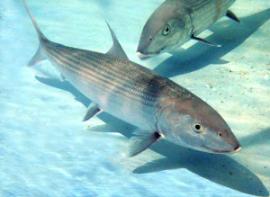New Species of Bonefish
 Bonefish are one of the most popular game fish found in the Caribbean. Anglers and marine lovers will be excited to hear that a brand spanking new species of Bonefish has recently been identified by geneticists at the Florida Fish and Wildlife Research Institute in St. Petersburg, Florida.
Bonefish are one of the most popular game fish found in the Caribbean. Anglers and marine lovers will be excited to hear that a brand spanking new species of Bonefish has recently been identified by geneticists at the Florida Fish and Wildlife Research Institute in St. Petersburg, Florida.
How do you find it? Unfortunately the new species can’t be identified by appearance. You can only tell the difference between the new, unnamed species and the two previously known by examining the DNA in the fishes dorsal fin. The discovery was based on samples of fish taken from the Florida Keys, the Bahamas, Mexico, and the Virgin Islands.
“Figuring out what’s in the fishery is a huge priority,” said Adams, who serves as director of operations and research for the nonprofit Bonefish & Tarpon Unlimited.
According to the Miami Herald,
Having the complete biological picture for bonefish is important because sport fishing is a multibillion-dollar economic engine in South Florida and the Caribbean. A five-year annual census conducted by scientists from the University of Miami shows every bonefish from Key Biscayne to the Marquesas in the lower Keys is worth $3,500 per year _ or $75,000 over its lifetime _ based on money spent on fishing tackle, boats and charters to chase the species.
That’s quite a valuable fish. Its easy to see why the experts are so intrigued about the animal’s life cycle and habits, none of which are known at this time.
The other two species of Bonefish, Vulpes and Garcia, are:
- Believed to spawn in deep, offshore waters around the full and new moons in winter and early spring. The larval phase is 42-72 days.
- Approximately 96% of juvenile bonefish captured by scientists or caught by taggers in South Florida were Garcia. All 12 juveniles caught by researchers on North Bight on Andros Island in the Bahamas were species Vulpes. All juveniles sampled at Turneffe Atoll in Belize were Garcias.
- Juvenile Garcias are believed to live along shallow, sandy beaches while juvenile Vulpes live in deeper, open sand bottoms.
- Adult Garcias are believed to live mostly in deep water, but have been found on flats.
- The animal’s growth rates vary widely by region. One 23-inch fish caught in the Florida Keys was determined to be 6 years old (based on counting rings on its earbone, similar to the rings on a tree trunk), but a fish of the same size caught on Andros was determined to be 8 years old and one on the British Virgin Islands, 16 years old.
- Bonefish diet varies by region. (So make sure your guide is local)
Via the Miami Herald